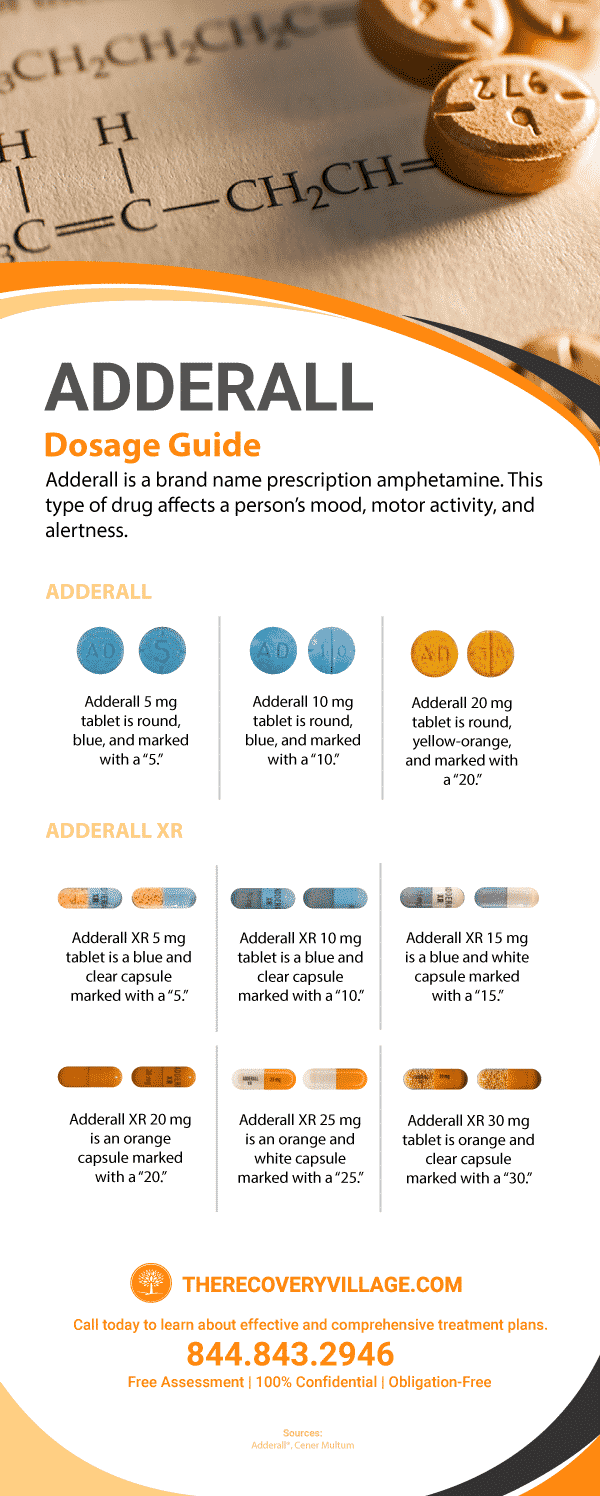There are many different Adderall dosages, and taking too much can lead to risky side effects. Learn more about what Adderall is used for and how much is typically prescribed.
When looking at Adderall dosage, there are distinctions between extended-release and immediate-release options. TheAdderall dosage instructionsare different for the two.
Article at a Glance:
- Adderall immediate-release works within 15-30 minutes and lasts 4-6 hours.
- Adderall extended-release works within 30-60 minutes and lasts for 10-12 hours.
- The adult Adderall immediate-release dosage is 5 mg to 40 mg per day, spread throughout the day.
- Adderall extended-release is taken in one daily dose, usually not to exceed 40 mg per day.
- It is very dangerous (and even potentially fatal) to use high dosages of Adderall to get high.
Adderall Dosage Guide/Chart
If you’re searching for an Adderall dosage chart, the following infographic provides a general overview of what an Adderall dosage might look like.

What Dosage Does Adderall Come In?
Adderall XR dosage begins at 5 mg. Then there are 10 mg, 15 mg, 20 mg, 25 mg, and 30 mg dosages.
The Adderall IR dosage options start at 5 mg and include 7.5 mg, 10 mg, 12.5 mg, 15 mg, 20 mg, and 30 mg. There is more flexibility in immediate-release dosages, allowing doctors to start patients out on a minimal dose and increase it incrementally.
[elementor-template id="4848"]Recommended Dosage for Adults
Doctors will usually start an Adderall dosage at the smallest amount that may potentially work and then gradually increase it. For ADHD, the immediate-release dosage for adults is between 5 mg to 40 mg a day. The dosage is divided throughout the day.
In regards to ADHD, doses of more than 40 mg a day are rarely more effective than lower amounts. For narcolepsy treatment, doctors may begin with 5 mg a day and then go up to 60 mg a day, with dosages given every four to six hours.
With Adderall XR, one dose is taken daily instead of in divided doses. A doctor may still recommend that the extended-release dosage not exceed 40 mg a day.
How Long Does Adderall & Adderall XR Work?
Adderall immediate-release (IR) starts working within 15 to 30 minutes and lasts for about 4 to 6 hours. Adderall extended-release (XR) can take about 30 to 60 minutes to start working, and it lasts for around 10 to 12 hours. Both IR and XR can lead to a crash as someone comes down from the effects of the drug, but XR tends to have less noticeable effects.
Avoiding an Adderall Dosage High
Trying to abuse Adderall to get highis very dangerous. At higher doses, it can be associated with sudden death. Determining how much Adderall would get someone high is almost impossible, as different people will have different reactions. Some people get high from Adderall by crushing and snorting it or dissolving and injecting it. These methods make the risks even greater.
It’s possible to experience afatal dose when using Adderallto get high, so this should be avoided. People should never take Adderall without a prescription from their doctor. If they do have a prescription, it should only be used as directed.
If you or a loved one is struggling with Adderall misuse, The Recovery Village is here to help. We encourage you to learn more about treatment plans and programs that can work well for your situation.
